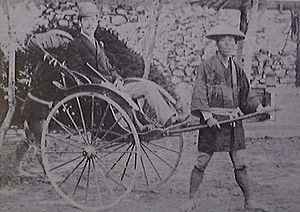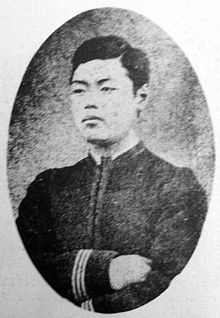- Ōtsu incident
-
The Ōtsu incident (大津事件 Ōtsu Jiken) was a failed assassination attempt on Tsarevich Nicholas Alexandrovich of Russia (later Tsar Nicholas II) on 11 May 1891, while Nicholas was visiting Japan during his eastern journey.
Contents
Background
Before opening ceremonies in Vladivostok marking the start of construction of the Trans-Siberian Railroad, Tsarevich Nicholas made an official visit to Japan. The Russian Pacific Fleet with the Tsarevich first called on Kagoshima, then Nagasaki, and then Kobe. From Kobe, the Tsarevich journeyed overland to Kyoto, where he was met by a delegation headed by Prince Arisugawa Taruhito. As this was the first visit by such an important foreign prince to Japan since those of Prince Heinrich of Prussia in 1880 and two British princes in HMS Bacchante in 1881, and as the military influence of the Russian Empire was growing rapidly in the far east, the Japanese government placed heavy emphasis on using this visit to foster better Russo-Japanese relations. Prince Nikolai showed interest in the Japanese traditional crafts, had a tattoo on his body,[1] and bought an ornamental hairpin for a Japanese girl who happened to be near him.
Details of the attack
The assassination attempt occurred on 29 April 1891 (on Julian Calendar, or 11 May of the modern Gregorian calendar), while Nicholas was returning to Kyoto after a day trip to Lake Biwa in Ōtsu, Shiga Prefecture. He was attacked by Tsuda Sanzō (1855–1891), one of his escort policemen, who swung at the Tsarevich's face with a saber. The quick action of Nicholas's cousin, Prince George of Greece and Denmark, who parried the second blow with his cane, saved his life. Tsuda then attempted to flee, but two rickshaw drivers in Nicholas's entourage chased him down and pulled him to the ground. Nicholas was left with a 9 centimeter long scar on the right side of his forehead, but his wound was not life-threatening.
Nicholas was rushed back to Kyoto, where Prince Kitashirakawa Yoshihisa ordered that he be taken into the Kyoto Imperial Palace to rest, and messages were sent to Tokyo. Anxious that the incident would be used by Russia as a pretext for war, and knowing that Japan's military was no match for Russia at the time, Prime Minister Matsukata Masayoshi advised Emperor Meiji to go immediately to visit the Tsarevich. The Emperor boarded a train at Shimbashi Station, and traveled through the night so as to reach Kyoto the following morning.
The following day, when Nicholas expressed a desire to return to his fleet in Kobe, Emperor Meiji ordered Prince Kitashirakawa Yoshihisa, Prince Arisugawa Takahito and Prince Arisugawa Taruhito to accompany him. Later, Emperor Meiji, ignoring protests from some senior statesman that he might be taken hostage, paid a personal visit to the Tsarevich, who was recuperating on a Russian warship in Kobe harbor.
Aftermath of the attack
 Tsarevich Nicholas at Nagasaki.
Tsarevich Nicholas at Nagasaki.
Emperor Meiji publicly expressed sorrow at Japan's lack of hospitality towards a state guest, which led to an outpouring of public support and messages of condolences for the Tsarevich. More than 10,000 telegrams were sent wishing the Tsarevich a speedy recovery. One town in Yamagata Prefecture even legally forbade the use of the family name "Tsuda" and the given name "Sanzō". When Nicholas cut his trip to Japan short in spite of Emperor Meiji's apology, a young seamstress, Yuko Hatakeyama, slit her throat with a razor in front of the Kyoto Prefectural Office as an act of public contrition, and soon died in a hospital. Japanese media at the time labeled her as "retsujo" (lit. valiant woman) and praised her patriotism.
The government applied pressure to the Court to try Tsuda under Article 116 of the Criminal Code, which demanded the death penalty for acts against the emperor, empress or crown prince of Japan. However, Chief Justice Kojima Iken ruled that Article 116 did not apply in this case, and sentenced Tsuda to life imprisonment instead. Although controversial at the time, Kojima's decision was later used as an example of the independence of the judiciary in Japan and one of the justifications for the revision of the unequal treaties.
Accepting responsibility for the lapse in security, Home Minister Saigō Tsugumichi and Foreign Minister Aoki Shūzō resigned.
The Russian government officially expressed full satisfaction in the outcome of Japan's actions, and indeed formally stated that had Tsuda been sentenced to death, they would have pushed for clemency; however, later historians have often speculated on how the incident (which left the Tsarevich Nicholas permanently scarred), may have later influenced his opinion of Japan and the Japanese, and how this may have influenced his decisions in the process up to and during the Russo-Japanese War of 1904–1905.
Later events
- Tsuda was sent to prison near Kushiro, Hokkaidō, and died of an illness in September of the same year.
- The rickshaw drivers who captured Tsuda, Mukaihata Jizaburo (1854–1928) and Kitagaichi Ichitaro (1859–1914) were later called to the Russian fleet by the Tsarevich, where they were feted by the Russian marines, given medals, and a reward of 2,500 yen plus an additional 1,000 yen pension, which was a tremendous sum for the time. They were celebrated in the media as national heroes. However, during the Russo-Japanese War, the admiration of their friends and neighbors turned sour, they lost their pensions, were accused of being spies, and had to suffer harassment from the police.
- In 1993, when the Russian government was attempting to verify whether or not bone fragments recovered from the Yekaterinburg murder site belonged to Tsar Nicholas II, a sample of the Tsar's DNA was required. Relics from the Otsu Scandal were examined to see if enough blood stains were present to make a positive identification possible, but the results were not conclusive.[2]
References
- Yoshimura Akira. Nikolai Sounan. Tokyo: Iwanami Shoten, 1993. ISBN 4-00-001700-4. (Japanese)
- Keane, Donald (2005). Emperor Of Japan: Meiji And His World, 1852-1912. Columbia University Press. ISBN 0-231-12341-8.
Notes
- ^ Keene, Emperor of Japan, Meiji and His World, pp.446. Nikolai had read Pierre Loti's Madame Butterfly before arriving in Nagasaki, and in imitation of Loti had a dragon tattooed on his right arm on May 4 in a painful operation that took 7 hours, from 9 PM to 4 AM.
- ^ http://www.facesofrussia.org/index.php?option=com_content&task=view&id=14&Itemid=9 Faces of Russia Past and Present
Coordinates: 35°00′25″N 135°51′53″E / 35.00694°N 135.86472°E
Categories:- Assassination attempts
- Politics of the Empire of Japan
- Politics of the Russian Empire
- 1891 in Japan
- Japan–Russia relations
- 19th century in Russia
- 1891 in Russia
Wikimedia Foundation. 2010.


